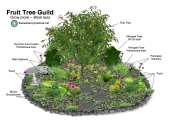posted 12 years ago
I would tend to agree with some of the previous posts in that you shouldn't worry too much about what it's called, just keep in mind what needs what and situate things appropriately with regards to sun/shade. In terms of growing plants/trees with longer-term yields, remember that trees such as the American Elm were often used in viticulture to support vines because it would grow straight and fast. Remember that their physical characteristics can be of use to other plant processes, and not just obstacles.
Also, I think it might be a good idea to break down the planning process into four dimensions. You obviously have a firm grasp on the first three, but unless you include time, you are blocking yourself from developing the Food Forest model that has as a benefit mature, nut-yielding trees. It's not as easy as planning the seasonal progress of, say, a garden plot, but similarities can be found. The approach I am taking in my planning is to consider the shade cast by the tallest trees I want to plant, and then forming a plan that is adapted over time to account for increasing shade. So in the first decade, your tall trees cast a shadow x number of feet long behind it (probably two values, one at equinox, the other at summer solstice, for ease of planning annual plantations at different parts of the season). So you know that in the places that are shaded by both values, the perennials you plant need to be shade-loving, as will the annuals, and you can count on part sun in the zone fully shaded only at solstice, and full sun outside those areas. From there, you can plan out a shade plan on a map of your space, and do different maps for each ten year slot. That will tell you where you can put plants that demand full sun, how far apart north-to-south to space young trees, and which to place where in relation to eachother. Personally, I am placing the trees that will be largest first so as to start with an established idea of my eventual sun limitations, and so to not overcrowd.
Remember also that there are different densities to forests, and that something more approaching savannah can be much more diverse, as there is much more edge. I think you should pick out what varieties of plant/tree life you want to fill out each stratum of your forest, start the plan with those ones that need the most sun, and of those, the longest-lived ones first, then fill in using a progressive shade map with shade-lovers in the darkest parts, and shade-tolerant perennials and annuals in the areas between full sun and full shade. I am looking at adapting alley cropping with hugelkultur in an east-west orientation, but with a wave to the alleys to produce sun scoops on the southward-facing concavities, and polyculture pasturage in the alleys between hugelbeets, which will form paddocks with closeable ends. Paddock-shift grazing (goats especially) will manage the pasture and keep forest vegetation from encroaching. As much as possible, I intend for all the species within this area to produce food either for humans or for the livestock. I am thinking of designating the northern and east/westernmost ends of the plan managed woodlot, where I'd gradually supplant what is/isn't there for what I want, acting in function primarily as a giant windbreak, also producing firewood and lumber, and also providing food sources for wild animals that would otherwise encroach elsewhere.
Well there I go again. I hope this tangent is useful to someone.
Cheers,
-CK
A human being should be able to change a diaper, plan an invasion, butcher a hog, conn a ship, design a building, write a sonnet, balance accounts, build a wall, set a bone, comfort the dying, take orders, give orders, cooperate, act alone, solve equations, analyze a new problem, pitch manure, program a computer, cook a tasty meal, fight efficiently, die gallantly. Specialization is for insects.
-Robert A. Heinlein








































 3
3








 1
1




 2
2




 1
1

















